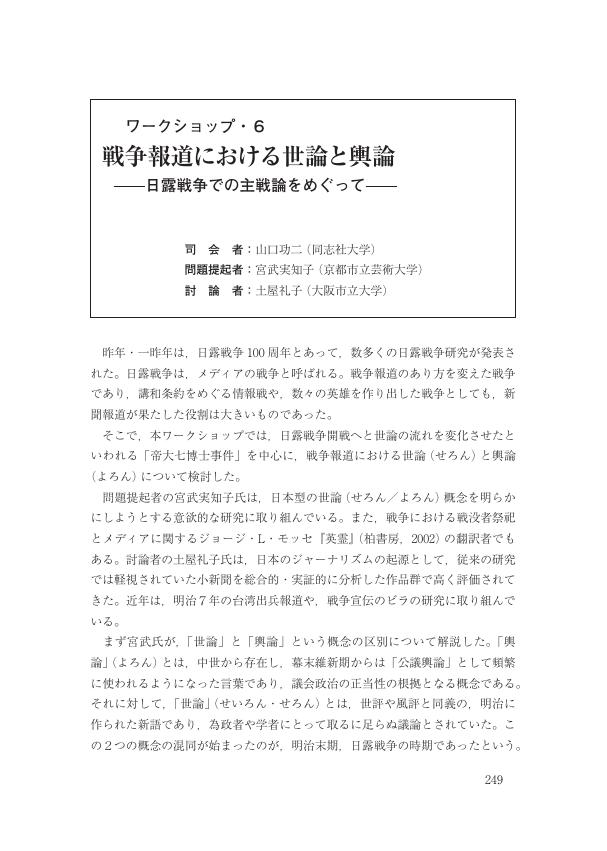3 0 0 0 日露戦争期の大衆紙における広告の数量分析
本研究では、大阪の二紙、『大阪毎日新聞』と『大阪朝日新聞』の明治36年(1903)から40年(1907)まで、および東京の二紙『時事新報』と『萬朝報』の明治36年から38年(1905)までの、各年一月の紙面に掲載された広告の数量分析を行った。その結果、総件数の月平均では『時事』が3,751件と最も多く、次いで『大阪朝日』3,203件、『大阪毎日』2,956件、『萬朝報』が2,010件と最も少なく、各紙の広告掲載量および広告収入への依存度の差異が明らかになった。また広告件数の増減では、大阪の二紙は共に、戦前の明治36年に比べて戦後の40年には約1.4倍増加しており、日露戦争期に新聞広告が飛躍的に発展したという通説を裏付けた。広告主旨別件数では、四紙とも商品宣伝の広告が最も大きい割合を占めたが、『萬』では六割以上と高く、『大阪朝日』『大阪毎日』では三割から四割、『時事』では三割程度と差異が見られた。大阪の二紙では商品宣伝に次いで年賀広告と事業広告の割合が高く、組織的かつ定期的な広告活動の比重が大きかったといえる。一方、東京の二紙は対照的に異なり、『時事』では商品宣伝以外では特定の分類への偏りがなく幅広いのに対し、『萬』は商品宣伝への集中度が突出して高かった。広告の大きさでは、五十行以上の大型広告の割合が大阪の二紙で高く、戦後には6-10%に達した。また絵図や写真使用などの視覚的デザインも大阪の二紙の方が使用頻度がほぼ二割以上と東京に比べて高く、特に戦勝広告の華々しさは際だっており、新聞広告の大型化とデザインの発展を牽引したのは大阪の新聞だったといえる。また広告主の地域性では、大阪の二紙では大阪の広告主が五割を、東京の二紙では東京の広告主が六-七割を占め、地域性の高さが明らかになった。なお大阪の二紙で東京の広告主が占める割合は7-12%に対し、東京の二紙で大阪の広告主が占める割合は1-3%と低かった。以上のように、新聞広告における大阪と東京の差異が明確に数量的に現れたのが本研究の成果である。
- 著者
- 山口 功二 宮武 実知子 土屋 礼子
- 出版者
- 日本メディア学会
- 雑誌
- マス・コミュニケーション研究 (ISSN:13411306)
- 巻号頁・発行日
- vol.70, pp.249-250, 2007-01-30 (Released:2017-10-06)
2 0 0 0 OA 聞き取り調査による戦後日本広告史の基礎研究
- 著者
- 土屋 礼子 竹内 幸絵
- 出版者
- 日本広告学会
- 雑誌
- 広告科学 (ISSN:13436597)
- 巻号頁・発行日
- vol.60, pp.17-33, 2014 (Released:2017-10-18)
2 0 0 0 対日宣伝ビラによるエフェメラ・メディアの基礎研究
エフェメラ・メディアのデータベースを構築するために、2009年度に引き続き、これまで収集してきた第二次世界大戦時の対日宣伝ビラの画像を同定しながら、全部で約8600点の資料画像を入力し、これを同一のビラごとに整理して番号を振り、各ビラの複数のイメージと英文説明資料をまとめて一つの項目として引き出せるようにした。その結果、約1700種類の対日宣伝ビラの資料が存在することが確認された。このうち、約350種類が英国制作、約350種類がオーストラリア制作、約800種類が米国制作であり、残り約200種類は中国制作また制作国不明のものである。さらに各ビラの日本語の文章をテキストデータとして入力した結果、キイワードによる検索が可能になった。これによる得られる幅広い知見の一部を示せば、日本人では「陛下」(67)という語による天皇への言及が多く、「天皇」(54)には明治天皇(9)が含まれ、「東條(首相)」(56)が次いで多いこと、国では「米国」(254)が最も多く登場するが、次いで「ドイツ(獨逸など)」(233)も多いこと、地名では「東京」(246)が最も多い以外は、「ビルマ」(199)「比島(フィリピンなど)」(187)など戦闘に関係した場所が頻出すること、敵国の軍隊では、「連合軍」(404)「米軍」(398)の言及が多く、他は「英軍」(81)「濠軍」(7)と極端に少ないこと、「爆撃」(308)は頻出するが、「原子爆弾」は1件しかないこと、「戦友」(176)よりも「指揮官」(143)「司令官」(119)への言及が多く、また戦争の責任の所在は、「軍閥」(112)に求められていること、戦争に否定的な「敗戦」(78)「戦死」(76)などの語が多く登場する一方で、「平和」(197)「自由」(125)「戦後」(121)といった肯定的で希望のある語も多いことなどが明らかになった。研究計画では、制作に関する情報や資料、流通散布や受け手に関わる情報などを付加する予定であったが、今年度ではビラの画像とテキストのデータベースを完成するだけで精一杯であり、その公開と拡充は今後の課題である。
2 0 0 0 OA 明治初期小新聞にみる投書とコミュニケーション
- 著者
- 土屋 礼子
- 出版者
- 日本マス・コミュニケーション学会
- 雑誌
- 新聞学評論 (ISSN:04886550)
- 巻号頁・発行日
- vol.41, pp.184-199,317-31, 1992-05-20 (Released:2017-10-06)
Following the publication of major newspapers addressed to the intelligentsia, there emerged a number of popular papers which were mainly directed toward the general public by the extensive use of furikana on the Chinese characters. These popular papers were relatively cheap and widely read, added an entertainment aspect to other papers, and functioned as a means of developing a new style of written Japanese. The ultimate objective of the present study is to clarify the development process of the new style of the language adopted by three representative popular papers, Yomiuri Shinbun, Tokyo Eiri Shinbun and Kanayomi Shinbun, during the period from 1875 to 1880. For this purpose, this study attempts to identify the nature and characteristics of regular readers by analyzing 8,352 letters from approximately 3,700 readers. Major findings of the present study are as follows: (1) Nearly half the letters were in fact contributed from regular readers, who accounted for a small proportion of the public. However, more than 70 percent of the contributors were residents of Tokyo, especially from the downtown sections of Asakusa, Nihonbashi, Fukagawa, and Shitaya. Of the 59 contributors for whom details could be ascertained, 57 were male and about half were merchants while the other half were of samurai origin and now professionally engaged in journalism or public service. (2) Regular contributors formed an informal support group for these papers and often gathered at the publisher in order to have direct communication. Their letters functioned as a source of news for other readers. More importantly, the conversation within the group was often directly written up as letters, thus preparing the way for the formation of a new style of written Japanese language.
1 0 0 0 OA 東アジアにおける歴史和解のための総合的研究
- 著者
- 梅森 直之 坪井 善明 田中 ひかる 土屋 礼子 小林 聡明 鈴木 恵美 鶴見 太郎 加藤 哲郎 李 成市 野口 真広 毛里 和子 山田 満 若林 正丈 篠田 徹 齋藤 純一 浅野 豊美 安井 清峰 最上 敏樹 土佐 弘之 山崎 眞次 八尾 祥平
- 出版者
- 早稲田大学
- 雑誌
- 基盤研究(A)
- 巻号頁・発行日
- 2015-04-01
東アジア諸国間の対話と交流は、歴史に由来する論争により妨げられており、そのため東アジアの歴史和解の試みは「失敗」であると総括されることが多い。しかしながら、東アジアにおける歴史認識には、単に戦争責任だけでなく植民地責任をめぐる問題が主題化されており、世界的に重要な先駆的実践として評価されるべきものがある。東アジアの各地域は、民主化と経済発展を、異なる時期に異なるプロセスとして経験し、そのため現在の歴史に関する国民感情にも、大きなズレが生じている。東アジア諸国がこのズレを認識し、既存の国際法体系の批判的に検討しつつ歴史共同研究を推進することで、東アジアの歴史和解を推進することが可能となる。
1 0 0 0 IR 沖縄戦における心理作戦と対日宣伝ビラ
- 著者
- 土屋 礼子
- 出版者
- 大阪市立大学大学院文学研究科
- 雑誌
- 人文研究 (ISSN:04913329)
- 巻号頁・発行日
- no.56, pp.25-43, 2005-03
第二次世界大戦において連合国軍は日本軍に対し、心理戦と呼ばれる宣伝ビラを主力としたプロパガンダを行った。本稿では国立公文書館蔵の第十軍諜報部心理戦班の報告書に基づき、その全体的経緯と当事者が行った評価方法を明らかにした。沖縄戦で用いられた宣伝ビラには三系統あり、一つはハワイ州オアフ島の米海軍太平洋艦隊司令部で作成されたナンバーシリーズ11種、二つ目は沖縄現地で作成されたXシリーズ17種で、これらの内容は日本軍将兵向けと沖細住民向けふたつに大別された。三つ目はやはり沖縄で作成された「琉球週報」と題する新聞形態のXNシリーズ6種である。1945年3月末から7月初めまでに総計八百万枚散布されたこれら宣伝ビラの効果については、日本側から投降した捕域の数、あるいは死者の数に対する捕虜数の比といった数値が評価基準として挙げられた他に、捕虜に対するアンケート調査や尋問による調査も行われた。その結果、日本軍や沖細住民に最も読まれた新聞形態の宣伝ビラが高く評価された。また、ビラのメッセージが心理的に与えた影響は明確ではなかったが、捕虜の数はそれまでの太平洋戦からは予想できなかったほど多く、沖縄における心理戦は成功であったと評価され、今後の戦闘においても心理戦が有効で必要であるとの結論が導き出された。一方、日本軍のプロパガンダは比較にならないほど貧弱なものであった。その後の日本本土攻撃および沖縄占領と日本の戦後統治を考える上でも、また朝鮮戦争などのそれ以降のアジアにおける戦争での心理戦を考える上でも、これらの心理戦の分析は重要な意味を持っている。
1 0 0 0 米国のメディアと戦時検閲 : 第二次世界大戦における勝利の秘密
- 著者
- マイケル・S. スウィーニィ著 土屋礼子 松永寛明訳
- 出版者
- 法政大学出版局
- 巻号頁・発行日
- 2004
- 著者
- 山本 武利 浅岡 邦雄 土屋 礼子
- 出版者
- 早稲田大学20世紀メディア研究所インテリジェンス編集委員会 ; 2002-
- 雑誌
- Intelligence (ISSN:13472275)
- 巻号頁・発行日
- no.14, pp.4-28, 2014-03
1 0 0 0 IR 初期の『都新聞』と『やまと新聞』について
- 著者
- 土屋 礼子
- 雑誌
- 人文研究 (ISSN:04913329)
- 巻号頁・発行日
- vol.51, no.9, pp.45-63, 1999-12
1)はじめに : 明治十七年(1884)に, 『今日新聞』と『警察新報』という二つの新たな小新聞(こしんぶん)が東京で誕生した。両紙はいづれも, それまでの小新聞にない新たな試みを行い, 後にそれぞれ『都新聞』と『やまと新聞』と改められて, 第二次世界大戦期まで存続する新聞の出発点となった。……
1 0 0 0 和解学創成へむけての全体調整と国際連携
1 0 0 0 戦争と植民地をめぐる和解文化と記憶イメージ
- 著者
- 土屋 礼子
- 出版者
- 日本マス・コミュニケーション学会
- 雑誌
- マス・コミュニケーション研究 (ISSN:13411306)
- 巻号頁・発行日
- no.83, pp.159-160, 2013-07-31
1 0 0 0 OA 明治初期小新聞にみる投書とコミュニケーション
- 著者
- 土屋 礼子
- 出版者
- 日本マス・コミュニケーション学会
- 雑誌
- 新聞学評論 (ISSN:04886550)
- 巻号頁・発行日
- no.41, pp.184-199, 317-316, 1992-05-20
Following the publication of major newspapers addressed to the intelligentsia, there emerged a number of popular papers which were mainly directed toward the general public by the extensive use of furikana on the Chinese characters. These popular papers were relatively cheap and widely read, added an entertainment aspect to other papers, and functioned as a means of developing a new style of written Japanese. The ultimate objective of the present study is to clarify the development process of the new style of the language adopted by three representative popular papers, Yomiuri Shinbun, Tokyo Eiri Shinbun and Kanayomi Shinbun, during the period from 1875 to 1880. For this purpose, this study attempts to identify the nature and characteristics of regular readers by analyzing 8,352 letters from approximately 3,700 readers. Major findings of the present study are as follows: (1) Nearly half the letters were in fact contributed from regular readers, who accounted for a small proportion of the public. However, more than 70 percent of the contributors were residents of Tokyo, especially from the downtown sections of Asakusa, Nihonbashi, Fukagawa, and Shitaya. Of the 59 contributors for whom details could be ascertained, 57 were male and about half were merchants while the other half were of samurai origin and now professionally engaged in journalism or public service. (2) Regular contributors formed an informal support group for these papers and often gathered at the publisher in order to have direct communication. Their letters functioned as a source of news for other readers. More importantly, the conversation within the group was often directly written up as letters, thus preparing the way for the formation of a new style of written Japanese language.




